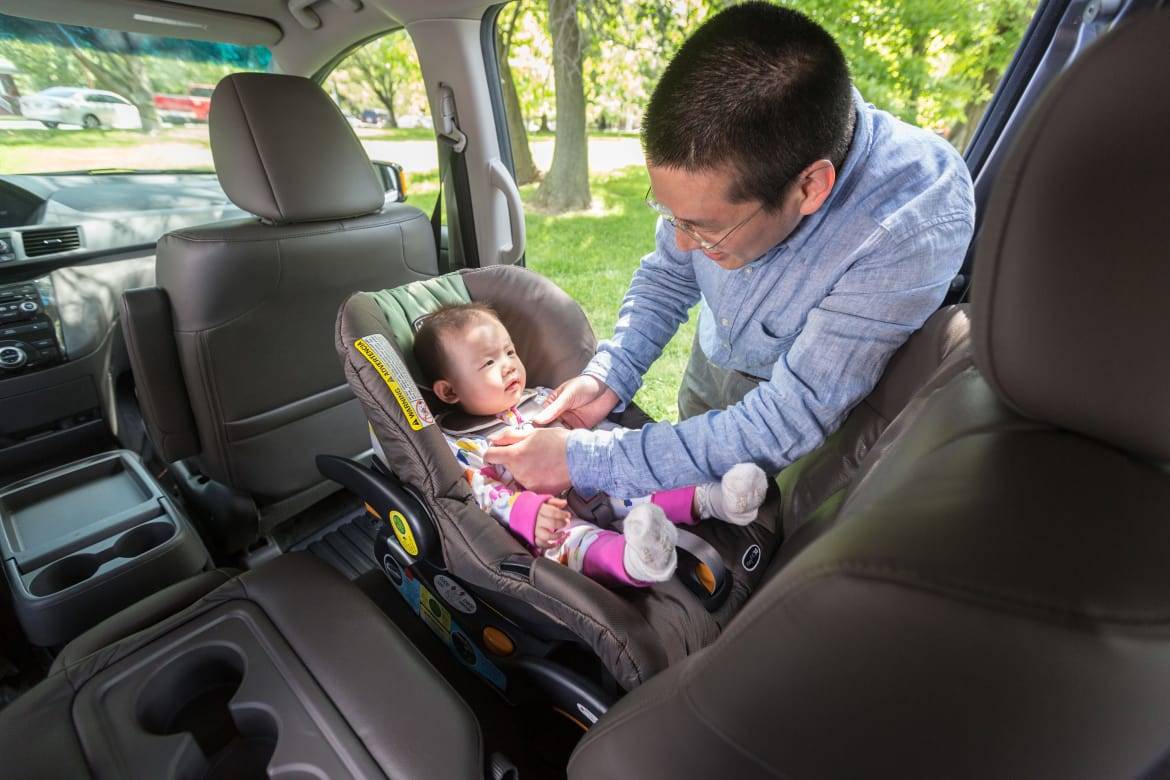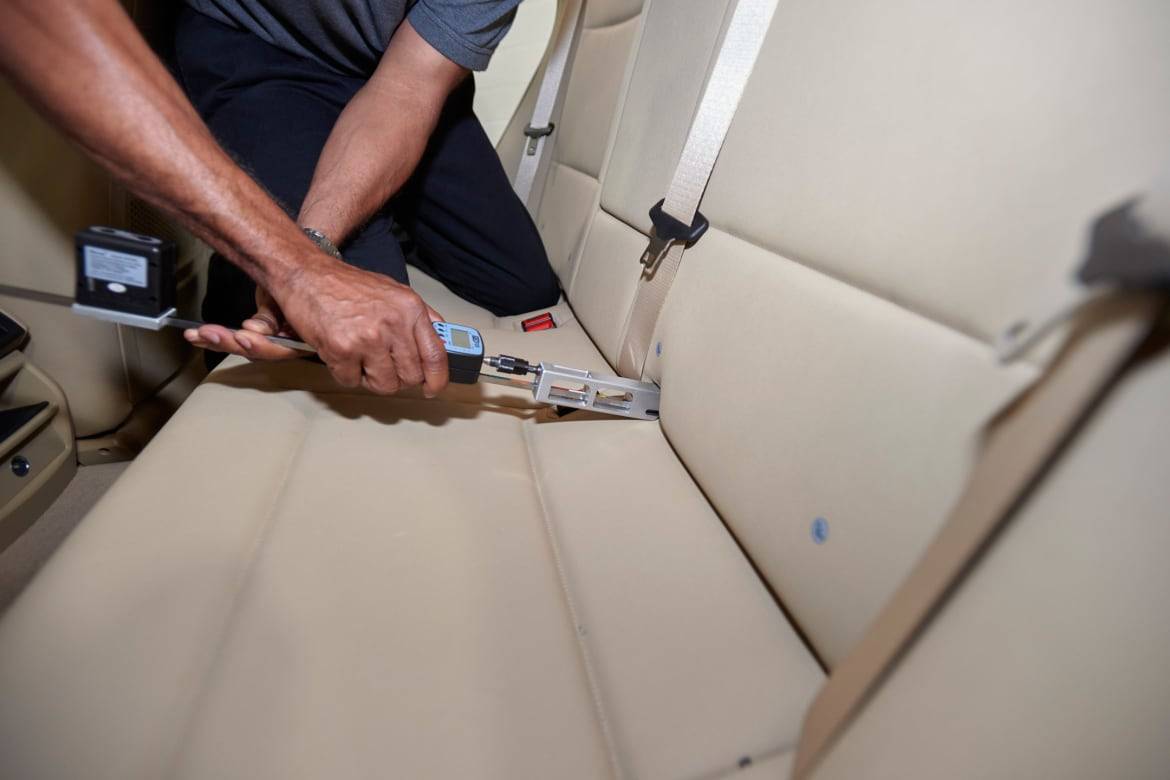IIHS Rates Latch Access in 102 Cars; Only 3 Earn Top Ratings


At Cars.com, we’ve been evaluating car-seat fit and ease of installation using a vehicle’s Latch system for more than five years and reporting our findings in our Car Seat Checks. The Insurance Institute for Highway Safety is now conducting similar tests. The agency today released results of its evaluation of 102 car models’ Latch systems and only three cars — the BMW 5 Series, Mercedes-Benz GL-Class and Volkswagen Passat — met its criteria for the top rating of good.
Related: How Cars.com Conducts Car Seat Checks
The Latch system uses two kinds of anchors to secure child-safety seats in a car’s backseat. The lower Latch anchors are found in the seat bight, the area where the back and bottom cushions meet. They come as a pair and are used with all kinds of car seats. Top tether anchors secure the top of a forward-facing convertible or combination seat, limiting a child’s forward head motion in a crash.
While the Latch system is federally required in any car with a backseat made after 2001, our tests have led us to conclude that some Latch systems are better than others.
IIHS’ latest tests concur. With only three cars earning the top score of good on a scale of good, acceptable, marginal or poor, 44 received an acceptable rating, 45 were judged marginal and 10 cars earned a poor score.

In IIHS’ tests, the Latch system is rated good if:
- The lower Latch anchors are no more than three-quarters of an inch deep in the seat bight, where the back and bottom cushions meet.
- The lower anchors have a clearance angle of more than 54 degrees, making them easy to maneuver around.
- The force required to attach a standardized tool to the lower anchors is less than 40 pounds; this simulates attaching a car seat’s Latch connector to the anchor, though the force required depends on the type of Latch connector on a particular car seat.
- Tether anchors are on the car’s rear shelf, which in a sedan is behind the rear head restraints, or on the top 85 percent of the seatback. Tether anchors shouldn’t be at the bottom of seatbacks, under seats, or on the ceiling or floor.
- There shouldn’t be any other hardware near the tether anchor that could be confused for it. If other hardware is present, the tether must be clearly labeled.
To receive an acceptable rating, two of a car’s Latch positions much meet at least two of the three requirements above for lower anchors and one of the two tether requirements. A car’s Latch system is rated as marginal if the tether requirements aren’t met in either position or only one lower Latch anchor requirement is met. Poor is the lowest grade, and a vehicle receives this rating when it meets fewer criteria than the marginal standard calls for.
The ratings are based on the two best Latch positions available in the second row. It’s important to note that Latch system configurations can vary depending on a car’s trim level. IIHS’ ratings are for the trim “believed to be the most popular.” All cars listed are model-year 2015 unless otherwise noted.
GOOD
- BMW 5 Series
- Mercedes-Benz GL-Class
- Volkswagen Passat
ACCEPTABLE
- Acura MDX
- Buick Enclave
- Chevrolet Cruze
- Chevrolet Equinox
- Chevrolet Impala
- Chevrolet Malibu
- Chevrolet Tahoe
- Chevrolet Traverse
- Chrysler 300
- Chrysler Town & Country
- Dodge Dart
- Dodge Durango
- Dodge Grand Caravan
- Ford Edge
- Ford Expedition
- Ford Explorer
- Ford Flex
- Ford Focus
- Ford Taurus
- GMC Terrain
- GMC Yukon XL
- Honda Civic
- Honda Odyssey
- Honda Pilot
- Hyundai Santa Fe
- Jeep Cherokee
- Jeep Compass
- Kia Forte
- Kia Optima
- Kia Sedona
- Kia Sorento
- Kia Soul
- Lexus GX
- Mazda3
- Mazda CX-5
- Mercedes-Benz C-Class
- Mercedes-Benz E-Class
- Mitsubishi Outlander Sport
- Nissan Maxima (2014)
- Nissan Murano
- Nissan Pathfinder
- Nissan Versa
- Toyota Camry
- Volvo S60
MARGINAL
- Acura RDX (2016)
- Audi Q7
- BMW 3 Series
- BMW X3 (2016)
- BMW X5
- Buick LaCrosse
- Cadillac SRX
- Chevrolet Sonic
- Chrysler 200
- Dodge Charger
- Dodge Journey
- Ford Escape
- Ford F-150
- Ford Fusion
- GMC Acadia
- Honda Accord
- Honda CR-V
- Hyundai Elantra
- Hyundai Sonata
- Infiniti QX60
- Jeep Grand Cherokee
- Jeep Wrangler
- Lexus CT 200h
- Lexus NX
- Lexus RC
- Lexus RX
- Mazda CX-9
- Mini Cooper
- Nissan Frontier
- Nissan Quest
- Nissan Rogue
- Nissan Sentra
- Ram 1500
- Subaru Forester
- Subaru Impreza
- Subaru Outback
- Subaru XV Crosstrek
- Toyota 4Runner
- Toyota Avalon
- Toyota Corolla
- Toyota Highlander
- Toyota Prius
- Toyota RAV4
- Volvo V60
- Volvo XC60
POOR
- Chevrolet Silverado 1500
- Ford Fiesta
- GMC Sierra 1500
- Hyundai Accent
- Lexus ES
- Mazda6
- Nissan Altima
- Toyota Sienna
- Toyota Tundra
- Volkswagen Jetta

Editor-in-Chief Jennifer Newman is a journalist with more than 25 years of experience, including 15 years as an automotive journalist at Cars.com. Jennifer leads the Editorial team in its mission of helping car shoppers find the vehicle that best fits their life. A mom of two, she’s graduated from kids in car seats to teens behind the steering wheel. She’s also a certified car-seat technician with more than 12 years of experience, as well as member of the World Car Jury, Automotive Press Association and Midwest Automotive Media Association. LinkedIn: https://www.linkedin.com/in/jennilnewman/ Instagram: @jennilnewman
Featured stories




